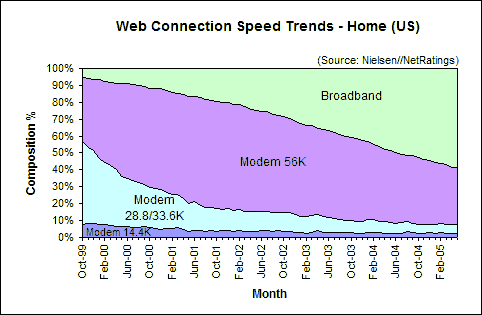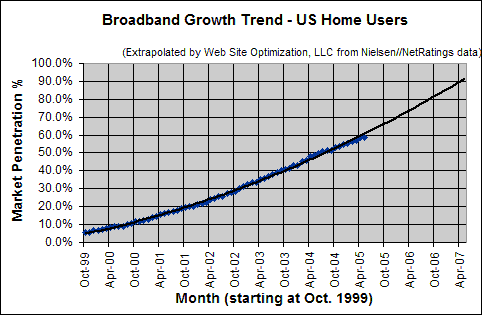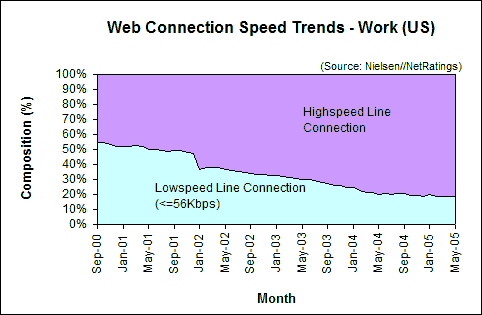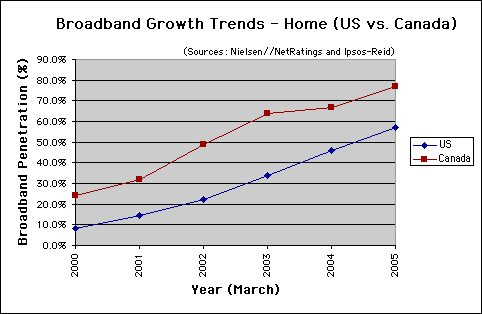Continuing last year’s trend, Canada leads the US in broadband penetration by 20 percentage points. As of March 2005, Canadians enjoy a broadband penetration rate of 77%, while only 57% of the wired US population has broadband. In May, US broadband penetration crept up by 0.36 percentage points to 58.82% among active Internet users.
The charts below, derived from Nielsen//NetRatings and Ipsos-Reid, show trends in connection speeds to the Internet for United States and Canadian users.*
Home Connectivity in the US
Most active Internet users connect from home with broadband connections. Among narrowband users, 33.76% use 56Kbps modems, 5.08% use 28/33.3Kbps, and 2.34% use 14.4Kbps modems. In total, 41.18% of home users in the US connect to the Internet at 56Kbps or less (see Figure 1).
Web Connection Speed Trends – Home Users (US)
Figure 1: Web Connection Speed Trends – Home Users (US)
Source: Nielsen//NetRatings
Broadband Growth in the US
Broadband penetration in the US grew by 0.36 percentage points to 58.82% in May, up from 58.46% in April. This increase is less than half the average increase in broadband of 0.85 points per month over the last twelve months. US broadband penetration growth appears to be tapering off in recent months. At the current growth rate, broadband penetration among active Internet users in the US should break 60% by mid-summer 2005 (see Figure 2).
Broadband Connection Speed Trend – Home Users (US)
Figure 2: Broadband Connection Speed Trend – Home Users (US)
Extrapolated from Nielsen//NetRatings data
Work Connectivity
Most workers in the US enjoy high-speed connections to the Internet. Most use a high-speed line such as a T1 connection, and share bandwidth between computers connected to an Ethernet network. The speed of each connection decreases as more employees hook up to the LAN. As of May of 2005, of those connected to the Internet, 81.55% of US users at work enjoy a high-speed connection, up 0.22 percentage points from the 81.33% share in April. At work, 18.45% connect at 56Kbps or less (see Figure 3).
Web Connection Speed Trends – Work Users (US)
Figure 3: Web Connection Speed Trends – Work Users (US)
Source: Nielsen//NetRatings
US-Canadian Broadband Penetration Gap at 20 Points
In North America, Canada is leading the US in the race for broadband domination. Continuing last year’s trend, Canada leads the US in broadband penetration by 20 percentage points. As of March 2005, Canadians enjoy a broadband penetration rate of 77%, while only 57% of the wired US population has broadband (see Figure 4).
Broadband Trends – Home Users (US vs. Canada)
Figure 4: US-Canadian Broadband Penetration Trends
Sources: Nielsen//NetRatings and
Ipsos-Reid
Broadband Households as Percent of Internet Households
| By Country | 2000 | 2001 | 2002 | 2003 | 2004 | 2005 |
|---|---|---|---|---|---|---|
| US | 8.1% | 14.5% | 22.3% | 33.8% | 46% | 57% |
| Canada | 24% | 32% | 49% | 64% | 67% | 77% |
Further Reading
- Ipsos-Reid
- Provides the Canadian broadband penetration data.
- Nielsen//NetRatings
- Provides the US broadband data (percentage of active Internet users) for the Bandwidth Report.
*Note that Nielsen//NetRatings reports the percentage of active Internet users that use broadband from home, not broadband households. NetRatings uses a panel of 40,000 to 50,000 people with software meters installed on their computers. These meters detect connection speeds. Each month they do an enumeration study to call a number of people to calibrate the panel by adjusting weightings to match the population at large.
The Bandwidth Report is featured monthly on URLwire – news of useful and unique web content since 1994.




